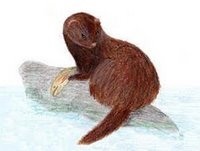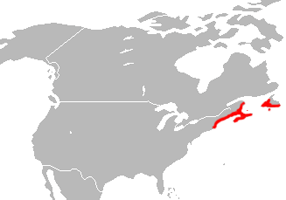[wp_ad_camp_1]
aka …Lutreola macrodon, Lutreola vison antiquus, Mustela vison macrodon, Neovison vison macrodon
The sea mink is thought to have been exterminated around about 1894 thanks to constant trapping for their fur. It was valuable because of its large size so the pelt fetched a higher price and it was actively sought by trappers.
People were even said to have used dogs to find the sea minks hiding in rock crevices and ledges then digging or smoking them out.

Appearance
As there is no record of a complete specimen of Mustela macrodon known to exist, the description is taken from recorded observations and the study of the bone fragments and teeth found at Indian middens along the coast of New England.
Said to be a larger and fatter version of M. vison, this animal had coarser and more reddish fur, a slightly bushy tail and had a distinctive odor, which was entirely different to the mink.
However I did see a comment that the zooarchaeological community doesn’t consider that the sea mink was in any way connected to the mink, saying it was distinct from all subspecies of the mink.[wp_ad_camp_2]
Size
Scientists have estimated the sea mink’s length of the head and body to be around 66 cm (26”) with the tail measuring 25.4cm (10”); however back in 1867 a person by the name of J B Gilpin recorded a sea mink in Nova Scotia as having an overall length of 82.6cm (32.6”).
Diet
It is believed that the sea mink probably ate fish, seabirds and their eggs and mollusks.
Distribution & Habitat

Sea Minks lived along the rocky coast from Newfoundland & the Maritime Provinces in Canada down to Maine & Massachusetts, as well as living on offshore islands along that coastline.
It’s believed that their dens had two entrances.
It’s listed as Extinct on the IUCN Red List of Threatened Species
I read a very depressing book called “The Sea of Slaughter” by Farley Mowat, and that had a short chapter about the way the sea mink was hounded to extinction for its pelt.
Farley Mowat, who was born in 1921, is a Canadian conservationist and one of the country’s most widely-read authors. “The Sea of Slaughter” was published in 1984.
| Extract from “The Sea of Slaughter” by Farley Mowat
Chapter 8 The Musk Bearers During the late 1700s, we have records on Nova Scotian whites and Micmac Indians regularly hunting sea mink on islands from La Have north to Halifax, to which town the pelts were taken to be sold. On one occasion, a Micmac woman was relieved there of several sea mink skins, plus the pelt of a bear, in exchange for a quart of wine. Less is known about its presence in the northern part of its range, but in 1766 French settlers at the northern tip of Newfoundland told Joseph Banks that “they every now and then see these animals in Hare Bay, and an old Furrier we spoke with told us he remembered a skin sold for give Guineas.” The Maine coast seems to have been a preferred habitat. Periodically, men with specially trained dogs would visit islands frequented by sea mink. They went in daylight because, perhaps as a consequence of their long persecution, the animal was largely nocturnal, feeding by night and lying up in the caves, rock crevices, and other such shelters by day. The dogs were quick to pick up what was described as the strong but not unpleasant musky scent of the quarry and would lead the hunters to its hiding place. If this could not be broken open with pick, shovel, and crowbar, the hunters might smoke the creature out with burning sulphur or pitch. If the crevice was shallow, they might fire black pepper into it from muzzleloading guns. If all else failed, they did not hesitate to insert powder charges and blow the refuge open, though odds were the animal would be so mutilated that its pelt would be worth little. Up to 1860, a few sea mink skins were still being offered for sale in Boston every year, but after that date it was seldom seen, alive or dead. The last Maine record is of one killed on an island near Jonesport in 1880. The last known survivor of the species anywhere was killed on Campobello Island, New Brunswick, in 1894. So perished a unique and, as Joseph Banks noted, extraordinary animal. Its like will not be seen again. Yet, for a time, something of it will remain. Scattered along the rock-bound coasts from Maine to Newfoundland are a number of small islands that once provided welcome haven to sea mammals and birds alike. Each bears the self-same name … now meaningless. Mink Island. |
How to say Sea Mink in different languages
- Arabic: تحرير
- Brezhoneg: Vizon mor
- Chinese: 海貂
- Croatian: Morska Vidrica
- Czech: norek mořský
- Danish: Langhalet hermelin
- Dutch: Zeenerts, Zeemink
- French: Vison de Merc / Vison des Mers / Vison Marin / Marte de Mer
- German: Seenerz / Seenerz / Meer Nerz / Seemink / Seeaffe
- Hungarian: Tengeri nyérc
- Italian: Visone Marino / Visone di Mare
- Japanese: ウミベミンク
- Portuguese: Vison marinho
- Russian: Морская норка
- Spanish: Visón Marino
- Turkish: Vison Deniz minki
- Vietnamese: chồn vizon biển
[wp_ad_camp_3]
Return from Sea Mink (Mustela macrodon) to All About Ferrets

wow this was so helpful